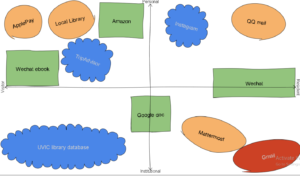Consider how you can use the PLN interactions of this course to further your digital identity post-term.
Mattermost serves as a professional and appropriate social media platform that helps me learn and communicate with my class this semester. What I’ve learned from the communication in the Mattermost is that I have to take the initial position to start a conversation in order to make everything else possible. At the beginning of the semester, I was a bit passive and timid about sharing my blogs with the class; and I would always read what others say in the group chat instead of participating. Looking back, I’ve lost many valuable opportunities to share my thoughts with my peers to produce better learning outcomes for all by creating a beneficial and competitive learning environment. In the future, I would actively and consciously use PLN interactions to get involved in communities to build a more accessible digital identity.
What does it mean to have a digital identity in your industry of choice, and can your current PLN be used to help professional development post-course?
I plan to start a career in education, and I’ve learned that having a digital identity becomes a necessity as education could take place online. Education is no longer limited to time and space, and it could even continue in challenging situations like the COVID-19. Realizing how the internet provides educators numerous learning resources, we must learn to make use of them. Professor Jesse Miller is a great example that I could follow. He invited many guest speakers to address issues and share their thoughts related to our topics during the course. I used to think of learning materials (e.g., textbooks, articles, videos and etc.) as learning resources, and he changed my mind. From another perspective, I learned that I need to connect with more people to diversify my PLN. My current PLN is mainly informative; it consists of academic articles, book reviews, and other learning materials. To achieve the professional development post-course, I must connect and include more human resources in my PLN.
Oliveira mentions the crucial notion of “collective intelligence” in the article. As the instructor, I will be responsible for the learning materials that the students will access in my class, and this learning process requires the media literacy and collaboration of both of us. (Oliveira, 450) Oliveira defines media literacy as “the ability a person has to perform, effectively, tasks in digital environments – including the ability to read and interpret media to reproduce data and images through digital manipulation and evaluate and apply new knowledge in digital environments.” (450) In my opinion, media literacy should be viewed as the ability to adapt new sources of information and identify the information’s validity. The development of this ability is crucial for every learner because the internet has already become our main source of information.
Additionally, as you progress through the steps of your career, can your PLN be relied on to open professional opportunities?
I still have to work a lot on my current digital identity to make it a possible aid in my future professional career. At the moment, my PLN could give me a kickstart in my future career, but it is not mature and fully functional. This year I aim to network more to expand my PLN to better prepare myself for professional opportunities.
Reference
Digital Identity of Researchers and Their Personal Learning Network – Digital Identity, PLN, & Conclusion pp. 469-475 Oliveira N.R., Morgado L. (2014) UVIC LIBRARY https://tinyurl.com/yz82x2ly Link- Springer https://link-springer-com.ezproxy.library.uvic.ca/content/pdf/10.1007%2F978-3-319-07485-6.pdf
